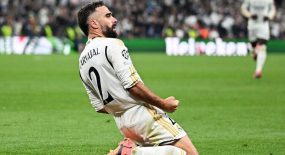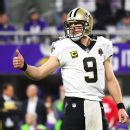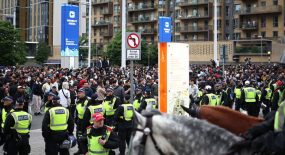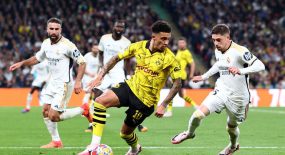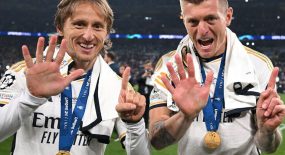Here are four storylines to watch as the Champions League enters the quarter-final stage, where teams can begin to set their sights on European glory.
Two legs might be enough for Juve to overcome misery of 2017

The misery of a decisive Champions League final defeat is undoubtedly fresh in the minds of Juventus players who were part of the Italian side that lost to Real Madrid at the Millennium Stadium in Cardiff last May.
It was a sobering performance, as Real Madrid ended Juve’s hopes of securing its first Champions League crown in over 20 years with a dominant 4-1 victory.
Cristiano Ronaldo has 7? goals in 5? games against Juventus ?#UCLdraw pic.twitter.com/Zrf3fPiNEw
— UEFA Champions League (@ChampionsLeague) March 16, 2018
Despite the heartbreak, there’s reason for optimism for the Serie A leader. While Juventus has fallen short in two finals against Los Blancos (1998, 2017), the Bianconeri have been victorious in all four meetings with Real Madrid that have spanned two legs.
The marquee matchup of the quarter-final stage is also one of the most common fixtures in European competition, as the two sides get set to renew acquaintances for the 20th and 21st time next month – only Bayern Munich and Real Madrid have played each other more frequently.
Liverpool has what it takes to end City’s European dreams

The chances of an all-England final were eliminated when the Premier League’s only representatives in the quarter-finals were drawn together in a balanced encounter between Manchester City and Liverpool, a match sure to provide its share of excitement over two legs.
Although there’s no easy pairing at this stage of the Champions League, it’s not difficult to imagine that Pep Guardiola would’ve wanted to avoid Liverpool in Friday’s draw.
The same can be said of Liverpool manager Jurgen Klopp as he attempts to prepare his team for a clash against what is arguably the best team on the continent. But the German has reason for optimism, as he continues to be the only manager to lead his team to a Premier League victory over a City outfit that’s dominated the competition in England’s top flight.
Liverpool? Ok, let’s go!!! #UCL pic.twitter.com/ctlFNbl8nN
— Kyle Walker (@kylewalker2) March 16, 2018
Despite an early-season loss while down a man, Klopp secured his fifth win against Guardiola-led teams when Liverpool’s blistering attack – led by Mohamed Salah, Roberto Firmino, and Sadio Mane – overwhelmed City en route to collecting three points during a thrilling 4-3 win in January.
After Friday’s draw, Klopp joked: “I think it’s an absolute dream draw … for all Manchester United fans!”
Bayern prepared for tricky Sevilla clash?
It won’t get any easier for Sevilla following the club’s triumph over Manchester United in the round of 16.
After dominating the Europa League for the last decade, Sevilla’s effort to elevate its status on the continental stage includes a pair of dates with Bayern Munich, one of the most storied clubs in football whose trophy cabinet includes five European titles.
“One ticket to Sevilla, paw favor!” ?? #MiaSanMia #UCLDraw pic.twitter.com/PHtOz1x8yA
— FC Bayern English (@FCBayernEN) March 16, 2018
The quarter-final encounter may seem like a relatively predictable matchup in Bayern Munich’s favour, but the runaway Bundesliga leader could be in for a surprise against a stubborn Sevilla team relying on the likes of Wissam Ben Yedder and Ever Banega to help eliminate the Germans.
Will Messi’s dominance over Italian teams continue?
Roma goalkeeper Alisson might be the Italian team’s only hope of progressing past a Barcelona team tipped to win this season’s Champions League.
Considering how the last meeting between the two played out, the tie could be over after the first leg if Barcelona is able to replicate the 6-1 drubbing it dished out to Roma at the Camp Nou during the Champions League group stage in 2015. Lionel Messi will look to add to his impressive record against Italian teams after scoring 12 goals – including a hat-trick against Roma – in 19 matches against Serie A opponents over the years.
The matchup is also another chance for Barcelona to return to the scene where the Catalan club won its third Champions League title after beating Manchester United 2-0 at Roma’s Stadio Olimpico in 2009.
When in Rome… ?
Great #UCL memories! ?? pic.twitter.com/VVYeY1LLJW— FC Barcelona (@FCBarcelona) March 16, 2018




